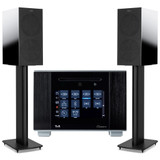| Although T+A have concentrated on progressive sources, this is not to the detriment of the DAB and FM tuners: T+A have fine-tuned their design to make best possible use of signals delivered by high-quality domestic aerials. The entire amplifier section is controlled by the integral DSP, which linearises and optimises the frequency response, switches and manages all the inputs and outputs, and controls the high-performance output stages. The latter are designed to cope with a vast range of loudspeaker types, are completely stable under load, capable of handling very high currents and are distortion-free even up to extreme volume levels. The mains section is totally stable over the full operating range, i.e. it never collapses, and has very high current reserves. |
The connection area on the back panel is an impressive reflection of the Caruso R’s versatile nature. From the first day of its development programme the Caruso R was intended to be the centrepiece of a versatile, high-quality Hi-Fi system. One key feature of this was the requirement for a wide-ranging array of sources, as sources should not represent a restriction: analogue and digital inputs cover every conceivable need from turntable with phono pre-amplifier to TVs and set-top boxes. USB inputs cater for mobile and network sources, while LAN, WLAN and Bluetooth sockets are also available, their signals converted by the SC 100 – the T+A streaming client. The Caruso is our first product to exploit SC 100, which provides access to services such as Gracenote Music ID, Airable Music Services, Spotify Connect, Apple AirPlay and Amazon Music via Alexa. The capabilities of the Internet are no longer just used – they are raised to a new level. |
It was back in the year 2008 that T+A introduced the first Caruso, and within a very short time the device won numerous prizes, gaining absolute cult status due to its unique overall design. In 2020 a new generation of the Caruso appeared, and this constituted the greatest advance yet in the history of these devices: the new version represented a completely new development – both externally and in technical terms. Although its heritage remains clear, the new Caruso epitomised the transformation of the machine from an all-in-one device to a series of individual products. |
















